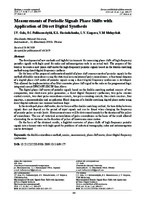Measurements of Periodic Signals Phase Shifts with Application of Direct Digital Synthesis

Date
2019Publisher
Another Title
Измерения фазовых сдвигов периодических сигналов с применением прямого цифрового синтеза
Bibliographic entry
Measurements of Periodic Signals Phase Shifts with Application of Direct Digital Synthesis = Измерения фазовых сдвигов периодических сигналов с применением прямого цифрового синтеза / I. V. Gula [et al.] // Приборы и методы измерений : научно-технический журнал. – 2019. – Т. 10, № 2. – С. 169-177.
Abstract
The development of new methods and high-bit instruments for measuring phase shifts of high-frequency periodic signals with high speed for radar and radionavigation tasks is an actual task. The purpose of this work is to create a new phase shift meter for high-frequency periodic signals based on the double-matching method using direct digital frequency synthesis. On the basis of the proposed mathematical model of phase shift measurements of periodic signals by the
method of double coincidence using the statistical accumulation of pulse coincidences, a functional diagram
of a digital phase shift meter of periodic signals using a direct digital frequency synthesizer is developed. This allowed the implementation of an 8-bit converter phase shift signal to the code on the programmed logic integrated circuit EPM240T100C5N firm Altera. The digital phase shift meter of periodic signals based on the double-matching method consists of two comparators, two short-wave pulse generators, a direct digital frequency synthesizer, two pulse counter
control circuits, two short pulse coincidence circuits, two pulse counting circuits, four clock counters, four registers, a microcontroller and an indicator. Block diagram of a double-matching digital phase meter using direct digital sintesizer use minimal hardware logic. In the developed phase shift meter, due to the use of the double-matching method, the time delay between signals does not depend on the period of input signals and can be found when changing the frequency
of periodic pulses in wide limits. Measurement errors will be determined mainly by the duration of the pulses
of coincidence. The use of statistical accumulation of pulse coincidence in the basis of the work allowed eliminating the restrictions on the duration of pulses of known non-ionic meters. On the basis of the obtained results, a high-bit converter of phase shifts of high-frequency periodic signals into a binary code with high speed for problems of industrial tomography, radar and radionavigation can be developed.
Abstract in another language
Разработка новых методов и высокоразрядных средств измерения фазовых сдвигов высокочастотных периодических сигналов с высоким быстродействием для решения задач радиолокации, радионавигации является актуальной задачей. Целью данной работы являлось создание нового измерителя фазовых сдвигов высокочастотных периодических сигналов на основе метода двойного совпадения с использованием прямого цифрового синтеза частот. На основе предложенной математической модели измерения фазовых сдвигов периодических сигналов методом двойного совпадения с использованием статистического накопления импульсов разработана функциональная схема цифрового измерителя фазовых сдвигов периодических сигналов с использованием прямого цифрового синтезатора частот. Это позволило реализовать 8-разрядный преобразователь фазового сдвига сигналов в код на программируемой логической интегральной схеме EPM240T100C5N фирмы Altera. Цифровой измеритель фазовых сдвигов периодических сигналов на основе метода двойного совпадения состоит из: двух входных устройств, двух формирователей коротких импульсов, прямого цифрового синтезатора частоты, двух схем управления счетчиками импульсов, двух схем совпадений коротких импульсов, двух схем управления счетчиками импульсов, четырех счетчиков тактовых импульсов, четырех регистров, микроконтроллера и индикатора. Предложенная блок схема реализации измерителя имеет минимальную аппаратную сложность. За счет использования метода двойного совпадения временная задержка между сигналами не зависит от периода входных сигналов и может быть найдена при изменении частоты периодических импульсов в широких пределах. Погрешности измерения будут определяться в основном только длительностью импульсов совпадений. Использование в основе работы статистического накопления импульсов позволило устранить ограничения на длительность импульсов известных нониусных измерителей.
На основе полученных результатов исследования разработан высокоразрядный преобразователь фазовых сдвигов высокочастотных периодических сигналов в двоичный код с высоким быстродействием для задач радиолокации и радионавигации.
View/
Collections
- Т. 10, № 2[10]
